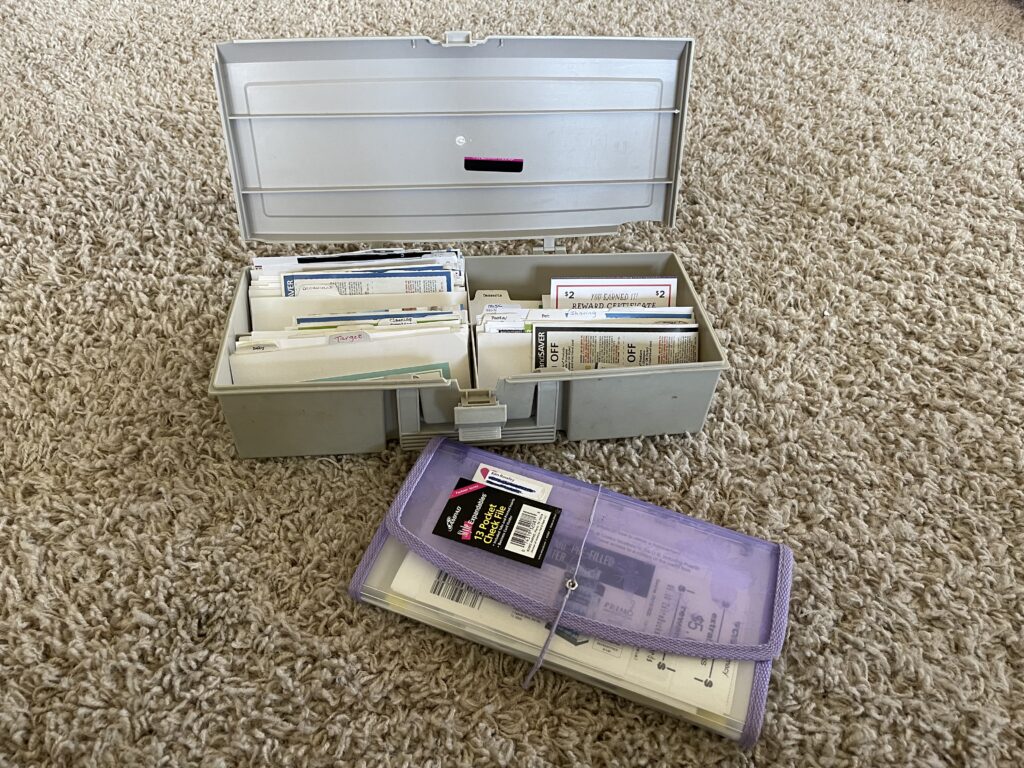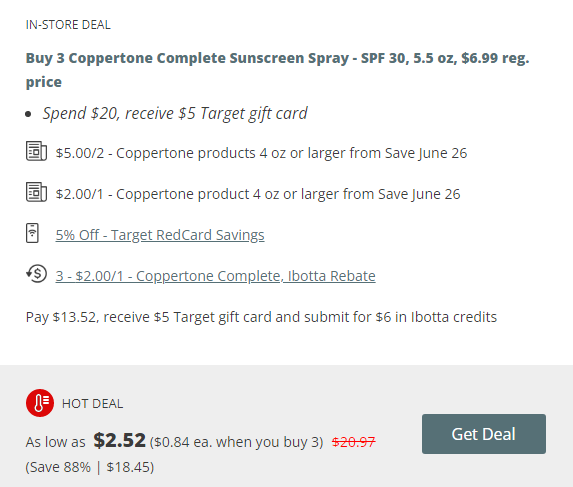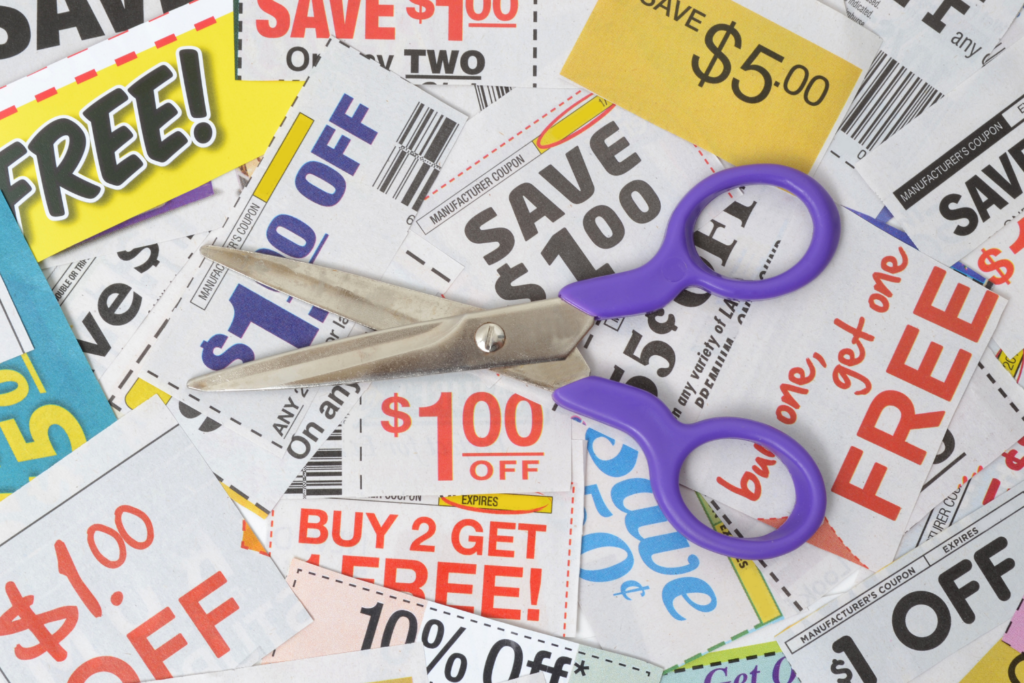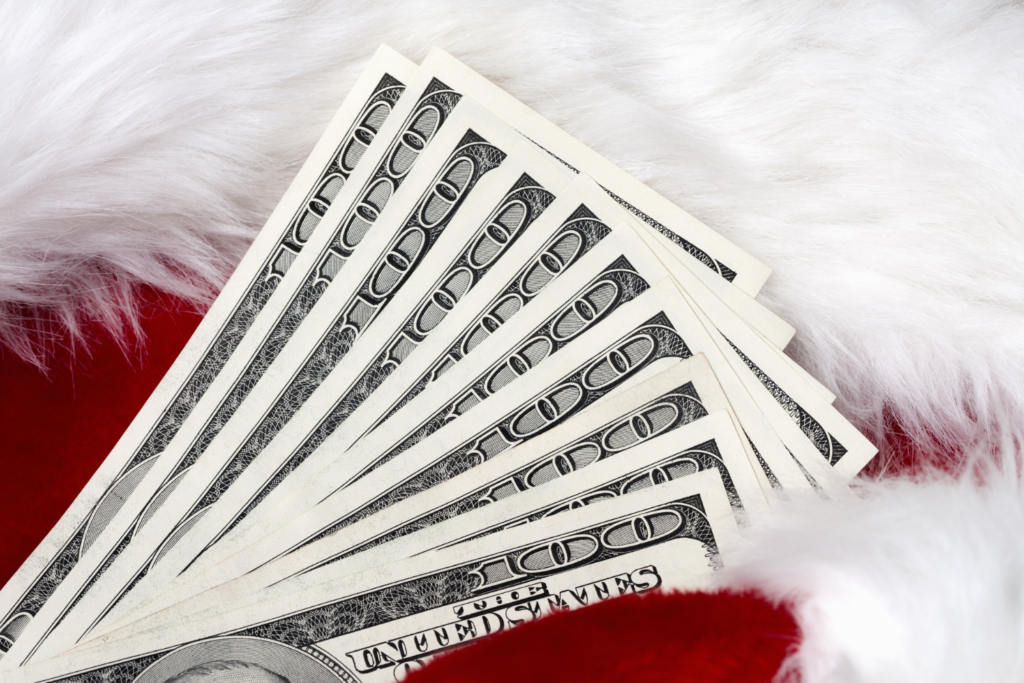
Years ago – pre-internet – when I was a young mother of four young children on a tight budget, I relied heavily on couponing and refunding to save money on groceries and household items.
Contents
What is Couponing?
Couponing is defined as the act of using a coupon to obtain a discount on an item. Couponing has become increasingly popular over the years as people have become more mindful of their spending.
For those of you who are unfamiliar with couponing, let me give you a brief overview. Couponing has been around for a long time, but it gained mainstream popularity in 2010 with the TLC show Extreme Couponing. The show followed people who were able to get hundreds or even thousands of dollars worth of groceries for very little out-of-pocket expense by using coupons.

While the show was entertaining, it also gave couponing a bad rap because it made it look like people were taking advantage of the system and hoarding items that they may never use. In reality, couponing is a perfectly legal way to save money on groceries and other items, and it can be done without going to extreme measures.
My Story
I had a big plastic coupon box with dividers that I had ordered from a Refunding Make Cents, a now-defunct refunding magazine by Michele Easter, with dividers to divide my coupons that my kids cut out for me into categories (keep scrolling for photo). I subscribed to the Sunday newspaper for the coupon inserts as well as scoped magazines and brochures in doctor’s offices for any money-saving coupons. I wasn’t ashamed to gently rip coupons out of magazines as I had a lot of mouths to feed!
I then scoped the weekly ads from the big box retailers in my area and matched up coupons I had for the sale items. Some stores offer double and even triple coupons which meant if you had a $1 off coupon, they’d take $2 off (or $3 off if tripling). And some would let you keep the overage if the item was under $2 meaning that you got paid to buy that item! I would travel hours with my coupon box, which took up the whole baby seat in the shopping cart, to those sales walking up and down each aisle researching every product coupon I had to see if it would be a good deal.
Once I had internet access, a whole new world opened up for me! Not only did I now have access to printable coupons, but I had access to weekly ads before they were live so I could be the first in line to shop (as many hot deals sold out quickly). I had a “free room” in my house for my stockpiles of health and beauty aids and toiletries.
Then came digital coupons and mobile apps and tons of “coupon match-up” bloggers that did all the work for everyone, so I just had to search the deals and coupons and go shopping. I was even a coupon match-up blogger for a while on my previous blog (you can read the story here). Every week, I’d do a “$6 Target Trip” showing exactly how I got a cartload of goodies from Target for six dollars or less by combining sales with coupons and rebates and “double-dipping” with Target coupons and using the Target Red Card. Those were the days.

I got approached about being on an episode of TLC’s Extreme Couponing, but there were no double or triple coupon sales going on at the time they wanted to film, so I wouldn’t have been able to get a good haul for the show.
Couponing can become time-consuming. I may have originally started out of necessity, but it turned into a hobby where I got a thrill seeing how much money I could save and how many items I could get for little to nothing.
Now that my kids are grown and I’m not in that financial pinch any more, I basically stopped using coupons and let my coupon box collect dust. But now that inflation is increasing faster than ever, I’ve started couponing again.
Why Is Couponing Making A Comeback?
There are a number of reasons couponing is making a comeback. One reason is the current state of the economy. With the cost of living rising and wages staying the same, people are looking for ways to stretch their dollars. Using coupons is one way to do that.
Another reason couponing is gaining popularity is because of the ease of access to coupons. In the past, you had to buy a Sunday paper or keep your eye out for coupons in magazines and brochures. Nowadays, there are a number of websites and apps that offer coupons and deals on a variety of items. This makes it easier than ever to save money on the things you need and want.
Lastly, couponing is becoming popular because it’s a great way to save money on organic and natural items. In recent years, there has been an increase in the demand for organic and natural products. However, these items can be pricey. Couponing can help offset the cost of organic and natural items, making them more affordable for people who want to live a healthy lifestyle.
How to Get Started With Couponing
If you’re interested in couponing, there are a few things you should know before getting started. First, familiarize yourself with couponing lingo and common terms (below). This will help you understand coupons and deals better. Second, create a system for organizing your coupons. This can be as simple as a couponing binder or an app on your phone. Third, take advantage of resources like couponing websites and blogs to learn tips and tricks from experienced couponers.
Types of Coupons
There are two types of coupons – manufacturer’s coupons and store coupons.
- Manufacturers’ coupons are issued by the company that manufactures the product and can be used at any store that sells that product.
- Store coupons are issued by the retailer and can only be used at that particular store.
A lot of stores allow the use of a manufacturer coupon with a store coupon which is considered a “double play”. Items purchased with coupons can also be stacked with rebates or refunds. These can be forms that need to be mailed in with your receipt, forms filled out online, or via mobile apps. Using three methods of savings is then considered a “triple play”.
Couponing Terminology
Here is a list of common couponing abbreviations and coupon lingo used by fellow couponers, past and present.
- B&M = Brick & Mortar
- B1G1 or BOBO = Buy One Get One usually free or at a discount.
- BLINKIE = In-store coupons, usually in a red blinking box near the item.
- BTFE = Boxtops for Education
- C/O = Coupon
- Catalina = Coupon Printed at Checkout
- CRT = Cash Register Tape (i.e. your receipt)
- DND = Do Not Double
- EPOP = Each Pays Own Postage
- FAR = Free After Rebate
- GDA = Good Deal Alert
- GM = General Mills
- HBA = Health & Beauty Aids
- IP = Internet Printable coupon
- LSASE = Long SASE
- Match-up = Matching a coupon with a sale
- MFG or MQ = Manufacturer’s Coupon
- MIR = Mail-In Rebate
- NAZ = Name, Address, Zip
- NED = No Expiration Date (these coupons are nearly non-existent now)
- OAS = One Any Size
- OOP = Out Of Pocket (how much money you actually pay at the register)
- OOS = Out of Stock
- P&G = Proctor & Gamble coupons found in Sunday newspapers.
- Peelie = Coupon on the product package that you peel off.
- POP = Proof of Purchase
- Q = Coupon
- SASE = Self-Addressed Stamped Envelope
- SMP = Specially Marked Package
- SS = SmartSource coupons
- Tearpad = A pad of coupon or rebate forms.
- TMF = Try Me Free
- UPC = Universal Product Code
- WSL = While Supplies Last
- WYB = When You Buy
- YMMV = Your Mileage May Vary – basically this means that the deal may not be available in your area or at your local store.
Where To Find Coupons
There are a few different ways of couponing. You can get coupons from the Sunday paper, in-store circulars, or from online sources. A lot of coupons nowadays are digital, meaning they can be redeemed online or via a mobile app. However, you can still find paper coupons in magazines, newspapers, and direct mailings from companies.
Newspapers
The Sunday edition usually has inserts of coupons, but other days may have a couple of coupons as well with the best days being Wednesdays and Saturdays. For the best price on the Sunday paper, check out your local Dollar Tree. Or see if the newspaper has any specials if you sign up for home delivery.
Magazines
Check national and local magazines for manufacturer and local store coupons.
Doctor’s Offices
Doctors regularly get tearpads of coupons for over-the-counter medications. For example, I’ve gotten Pepto-Bismal coupons at a gastro-intestinal doctor’s office, and Pre-Natal Vitamin coupons from an OB/GYN’s office. You can also skim the magazine selections in the waiting room for coupons.
Request Them
If there is a brand that you absolutely love and/or are loyal to, reach out to their customer service via telephone, email, or contact form and simply ask if any coupons are available. Some companies will send you coupons for free full-size items. You can also sign up for free catalogs which will get you on mailing lists for other products, so skim your junk mail for hidden goodies.
Printable Online
The best source for printable coupons is Coupons.com. If you are looking for a specific brand coupon, search the brand website or google the brand name plus the word “coupon” to see if any options come up. Most sites will only let you print one (or possibly two) of the same coupons. They track this by setting cookies on your computer so your computer knows you already redeemed the offer. This was one of the controversies with some of the Extreme Couponers. They would delete their cookies or use multiple computers to be able to print several of the same coupons. I don’t suggest going to that extreme, but I think it’s safe to ask a partner or friend to print an extra coupon for you once in a while.
P&G Good Everyday offers printable coupons for their products which includes such brands as Align, Always, Ariel, Bounce, Bounty, Charmin, Crest, Downy, Dreft, Febreze, Fixodent, Gain, Gillette, Head & Shoulders, Mr. Clean, Nervive, Olay, Oral B, Puffs, Scope, Swiffer, Tide, Venus, Voost, and more. They had coupons for all of the mentioned brands the last time I logged in. Print P&G coupons now (you will need to register first if you’re not yet registered, but it’s free).
BettyCrocker.com and Pillsbury.com also offer printable coupons for their products.
Mobile Apps
There are several cash-back apps out there that you can double dip coupons with. Some, like Slide, simply give cash back by shopping at certain stores. While others, like Ibotta, give rebates back for buying specific products.
Buy Them
Yes, there are places where you can actually buy coupons. I believe it is technically illegal to charge for the actual coupon, so they have a disclaimer that you are paying for the coupon clipping service. You can order manufacturer’s coupons for pennies on the dollar from places such as The Coupon Marketplace and Klip2save.
How To Organize Your Coupons
Once you have your coupons, it’s time to organize them! This will help you keep track of what coupons you have and where they are so you spend less time hunting for the right coupons while at the store.
Below is a photo of my retired coupon box (although I may dust her off) and my current coupon organizer which is simply a pocket check file. Several couponers (and most of those on Extreme Couponing) use 3-ring binders with baseball card sleeves to organize their coupons. I personally tried that, and it wasn’t for me.

Some people organize their coupons by category (this is what I do). Some people sort their coupons alphabetically by brands. And some people sort their coupons by expiration date so they are sure to use certain coupons before they expire. There is no right answer here. Simply sort them how you feel would be the easiest to find what you’re looking for.
No matter, what organization tactic you use, be sure to include your name, address, and phone number somewhere in or on your coupon organizer in case you accidentally leave it in a shopping cart or drop it in a parking lot. There’s valuable merchandise in there that you don’t want to lose!
Plan Your Attack
It used to be that you had to wait for the advertisement to come out in the mail to see what sales were going on and then search your coupons to match them up. But nowadays, bloggers have access to ads early, so they do all of the hard work for us! They get paid for you visiting their websites and clicking their links, so it’s a win/win situation for all.
Here’s my couponing match-up routine:
First, for each shopping excursion, I use an envelope that I received from junk mail (or a bill that I paid online) to write my list on and put the coupons inside that I know I am going to use.
Then I search for match-ups for the stores near me. Or if I’m going out of town, I’ll make a list of stores in that area. The big stores in my area that have decent deals are Dollar General, Target, Walgreens, CVS, and Walmart.
Next, Google the store name with “coupon matchups”. If the newest deals aren’t at the top of the results, click “Tools > Any time > Past 24 hours”. For instance, I googled “Target Coupon Matchups” which led me to The Krazy Coupon Lady website.
Finally, I write down all of the deals that I want to (and can) take advantage of. I say “can” because sometimes I don’t have the correct coupon. This could be because I didn’t get a Sunday newspaper bought or even some regions get different dollar amounts off on their coupons.
Here is an example of a Target coupon matchup deal from their website:

And here is how I would then write the deal down on my envelope to take advantage of:
3 Coppertone Sprays – $5/2 & $2/1 c/o – $6 Ibotta
This tells me to buy a quantity of three Copperstone sprays, use two manufacturer coupons (one for $5 off 2 and one for $2 off one) then submit a rebate on the Ibotta app for $6 back. I didn’t include anything about the 5% savings from using my RedCard because that is a given (I always use my RedCard when shopping at Target). Then I would put the two coupons needed inside the envelope. Then while at the store, I will cross off when bought and relook at the envelope when I get home to remember to submit my Ibotta refund.
Clear as mud? Good!
Couponing FAQs
Here are twelve frequently asked questions about couponing.
1. What is couponing?
Couponing is the practice of using coupons or promo codes to get discounts on purchases. Coupons are often available in weekly ads or online, and can be used for a variety of products including food, clothing, and household items.
2. How do I start couponing?
If you’re new to couponing, start by familiarizing yourself with couponing lingo and common terms. Then, create a system for organizing your coupons. And finally, take advantage of resources like couponing websites and blogs to learn tips and tricks from experienced couponers.
3. Where can I find coupons?
There are a few different places to find coupons. The first place to look is the weekly ad from your local grocery store. You can also find coupons online, either on couponing websites or on the websites of the companies whose products you’re interested in purchasing.
4. How do I use coupons?
When you’re at the store, present your coupons to the cashier at checkout. They will scan the barcodes and apply the discounts to your total. Finally, couponing can take some time and effort to get started. But once you get the hang of it, you’ll be saving money in no time!
5. What are some couponing tips?
Once you have a few couponing tips under your belt, you’ll be surprised at how much money you can save. So start clipping those coupons and enjoy the savings!
6. How do I know if couponing is right for me?
Couponing is a great way to save money, but it takes time and effort to do it right. If you’re not willing to put in the time and effort, couponing may not be right for you. However, if you are willing to put in the work, couponing can be a great way to save money on groceries and household items.
7. What are some common couponing mistakes?
There are a few common mistakes that people make when they start couponing. One mistake is not familiarizing themselves with couponing lingo and common terms. Another mistake is not having a system for organizing their coupons. And finally, some people try couponing without taking advantage of resources like couponing websites and blogs.
8. Can I use coupons on sale items?
Yes! One of the best ways to save money with couponing is to combine coupons with sales. This will help you get the biggest discount possible. Just be sure to read the fine print on your coupons so you know how they can be used.
9. What are the top retail stores that accept manufacturer coupons?
Here is a list of some of the main big brand stores that accept coupons (and most local grocery stores accept manufacturer coupons as well):
- CVS
- Dollar General
- Dollar Tree
- Fred Meyer
- Fry’s
- Giant
- Harris Teeter
- King Soopers
- Kroger
- Lowe’s Foods
- Meijer
- Menards
- Publix
- Rite Aid
- Target
- Walgreens
- Walmart
- Winn-Dixie
List of stores that do NOT accept manufacturer coupons:
- Aldi
- Amazon
- Costco
- Sam’s Club
10. Why do stores accept manufacturer coupons?
There are a few reasons why stores accept manufacturer coupons. First, it helps them attract customers. Second, it helps them build brand loyalty. And finally, it helps them increase sales.
11. How many manufacturer coupons can you use per item?
Most stores allow you to use one manufacturer coupon per item. However, some stores may have limits on the number of coupons you can use per transaction. Be sure to check with the store before using multiple coupons.
12. Are there any restrictions on using coupons?
Yes, there are a few restrictions on using coupons. Most coupons have an expiration date and can only be used for a certain period of time. Additionally, some coupons may be limited to certain products or sizes. And finally, some coupons may only be accepted at certain stores.
13. What stores accept competitor coupons or price matches?
Several stores not only accept manufacturer coupons, but they also accept competitor coupons and/or match the advertised price of another store. Here is a list of those fifteen stores:
- Bed Bath & Beyond – Will price match on identical items (model numbers must match) including online stores. They will price-match Amazon if Amazon is the seller (no third-party Amazon sellers). They will not match membership clubs either.
- Bi-Lo – Limit 10 competitor coupons per day (one coupon per like item per day per customer).
- Dick’s Sporting Goods – Will price match on identical items (need to bring in competitor’s ad)
- Fred Meyer – Accepts pharmacy competitor coupons only.
- Giant
- Harris Teeter – Limit one competitor coupon per person per day.
- Home Depot – Will price match on identical items AND beat it by 10%.
- Kroger – Accepts pharmacy competitor coupons only.
- Lowe’s – Will price match local competitors, including a percentage off. Excludes clearance, special orders, liquidation items, and installation labor.
- Meijer
- Office Depot / Office Max – Will price match on identical items, even online stores.
- Publix – Accepts all types, even pharmacy coupons for prescriptions. Their competitor list is posted near the Customer Service counter.
- Walmart – Some managers allow price matching (mine doesn’t).
- Winn-Dixie – Limit 10 competitor coupons per day. Ask for the competitor list at the Customer Service counter.
- Target – Will price match on identical items, even online stores.
Ready? Let’s Review
The key to couponing is to only buy items that you will actually use. There’s no point in getting a great deal on an item if it’s going to end up in the back of your pantry and never get used. Also, be sure to pay attention to the expiration date on coupons so that you don’t end up with a bunch of expired coupons.
Couponing can be a great way to save money, but it’s not for everyone. It can be time-consuming, and it may not be worth the effort if you’re only saving a few dollars each week. But for those of us who are looking to cut our grocery bills, using coupons is definitely worth considering.
Happy Shopping!
- How Health Affects Wealth: A Case Study Of A Pinched Nerve - July 2, 2024
- Exploring The Different Types Liquidation Businesses - June 20, 2024
- Google SERP Update of March 2024 Unkind To Bloggers - May 20, 2024





